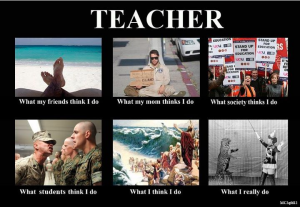Today’s exploration into what is at stake got the class’s passions bubbling, and it should. What is at stake is not only our future as educators, or the learning potential for our current and near-future students, but the future of education for all. In the article “Ipad versus Teachers” there is an implied either/or communicated. This is a misconception which can, and has, had devastating effects on the education system. When the implication is that all teachers do is “administer” curriculum and assign numbers to corresponding student responses it is clear that the vision of what it means to be an educator has been tainted from “old school” practices and deeply-seated conceptions of teachers. Although authentic changes are happening in numerous classrooms and schools around the world, it is going relatively unnoticed in the public’s mindset. The trouble is that these ideas are published again and again. If we don’t fill this space and become involved in the decision-making processes, no one else will. There are “triumphalists” as the article expounds, but where are the “educationalists,” where are the authentic learning or ideal classroom support lobbyists?
Through our small group discussions the absence of such voices became apparent. The diverse struggles experienced by Cherise, Merrin and Amy were completely unknown to me and Charlotte, and likewise, our structural and normative roadblocks were new to them. For example, in our school any Department Head release time that was saved, pre-booked and organized for significant professional development and collaboration was taken from us all year so we could cover classes when there was a TOC shortage. In contrast, for Cherise in Sooke, although classes were burgeoning, her school was able to utilize LIF funds for release time throughout the school year for professional collaboration and growth. We didn’t know what was occurring in schools or districts outside of our own, and if we don’t , how can we expect parents, politicians or the general public to? What was communicated in equal measure by all is the numerous roadblocks against learning opportunities for our students because of a lack of funding. The article “Ipads versus Teachers” also highlighted this issue as $500 + million is spent on tech tools for the school while an exorbitant amount of teachers are losing their jobs, and whole schools are being shut down.
Today there is more opportunity for connection and voice than ever before. This affords educators a power, and also a responsibility, to be the voices for their students. We need to be not combative, but conversational on our behalf. Teaching is an incredible complex and dynamic enterprise. As such, I find it is often reduced to the simplest terms by those outside of the profession. That is why we need to contextualize it through the expansive connective networks available to us. We need to show what it feels like to teach (like a hummingbird on caffeine, fluttering from unique student need to unique student need). We need to show what it sounds like to teach (a boisterous choir of sharing or as silent as Christmas Eve as students truly dive into themselves and their learning). We even need to show what it smells like to be a teacher (a young neglected boy wearing chronically unwashed, ill-fitting clothes who comes to school because it’s the only good thing in his world). We need to form connections and broaden perspectives so an iPad will never be in binary opposition to a highly trained, adaptable, masterful teacher.
All this being said, I tried to keep today’s issues at the forefront as I designed my future project. I have decided to include a forum for feedback on learning experiences/recommendations/opportunities, as well as student blogs and a peer feedback process similar to our own. I will also showcase student work throughout, and end the year with a portfolio gala (as I have done in the past), but this will be physical and virtual, and parents and friends will be invited to share in the experience. But this is just the shell, it’s how I execute that will allow for connectivity and communication of the learning occurring. Therefore, I’m creating a letter to parents and requesting an email, in which I will be able to periodically draw them to the virtual classroom to see, as fully as possible, what their child’s learning experience is. I have also researched a connective tool for students entitled Remind 101, in which a text messages may used to communicate with students or parents. All of this is not advocacy, it is promotion. I think that at least through this current endeavor I may provide more genuine connectivity and collaboration for my students’ learning, for their vital multiliteracy development. I am hoping that it will also help connect and communicate with parents, so even in the most senior years of their child’s education, they can “see” it, know it. Advocacy is a responsibility that I must take-up in other ways, such as through district study groups, in-school PLC and through engaging with Professional Learning Networks.

